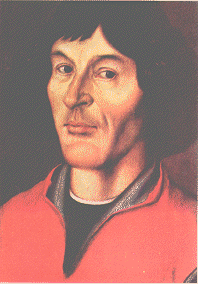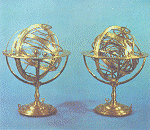
 |
How it works : Copernicus,Nicholas |
COPERNICUS, Nicholas (1473-1543)
 |
| Above: this portrait of Copernicus was painted about
100 years after his death-there are no surviving contemporary paintings.
Copernicus was not the first to suggest the 'heliocentric' or 5un-centred
theory: Aristarchus had the same idea in the 3rd century BC. But the classical writings of Ptolemy held sway, and few dared challenge them before the time of Copernicus. Even so, Copernicus still accepted the notion that orbits had to be circles-they are actually ellipses. |
Nicholas Copernicus, the son of a Polish merchant, was born at Torun, on the Visrula,on 14 February 1473. Ten years later his father died, and he went to live with his uncle, Lucas Watzenrode, Bishop of Ermland. After studying in Bologna and Padua, where he acquired knowledge of medicine, mathematics and astronomy, he returned to Poland. His uncle, to whose retinue he had been attached, died in 1512, and Copernicus then took up the post of Canon of Frauenhurg Cathedral.
The duties associated with this post were minimal, and Copernicus devoted the rest of his life to a study of the planetary motions. At that time the positions of the planets in the sky were computed from observations made centuries previously, on the basis of the Ptolemaic theory, according to which the Sun and planets all moved around the Earth, in circular orbits. At an early age, however, Copernicus realized that the predicted and observed planetary positions were in considerable disagreement.
In order to explain the movements of the planets even approximately, Ptolemy had proposed that each one moves in a small circle or epicycle, the centre of which revolves in a circular orbit around the earth. As errors crept in, fresh epicycles were introduced on an arbitrary basis; in Copernicus' time the system contained 80 epicycles and still was not providing accurate positions. Copernicus realized that a much simpler, and therefore more acceptable, explanation of the planetary motions arose from supposing the Sun to be at the centre, with the Earth and planers revolving around it.
By 1530, he was sufficiently satisfied with his proposition, which had been put forward before but never backed by observational evidence, to write a pamphlet, the Commentariolies, which he sent to several scholars. The reaction was discouraging, however, for an Earth centred universe was desirable theologically, and this consideration was more important than the accuracy (if the predictions. Copernicus had no doubt that his Sun centred system provided a more accurate explanation of planetary movements, even though he was forced to invoke epicycles, as Ptolemy had done: In a sense, the systems of Ptolemy and Copernicus are both incomplete because they make no attempt to explain why the celestial bodies move as they do.
 |
| Above: armillary spheres constructed on the Copernican (left) and Ptolemaic (right) systems. The complexity needed to explain the motions of the planets on the geocentric theory is obvious. |
By the time he circulated his pamphlet, Copernicus had already written a full length book, De Revolutionibus Orbium Coelestum ('On the Revolutions of the Heavenly Bodies'), dealing with the whole subject. His reluctance to publish this work has never been explained, and it was not until George Joachim Rheticus (1514-1576), his energetic disciple, under took the printing that the book finally appeared. Tradition has it that Copernicus received the first printed copy on his death bed. He died on 24 May 1543.
Although Copernicus had shown that a Sun centred system was plausible, the Ptolemaic theory was not universally abandoned for another century, by which time Johannes KEPLER had explained the movements of the planets perfectly by supposing them to move around the Sun in elliptical orbits, and Isaac NEWTON had provided the theory of gravity, which justified Kepler's explanation.
Reproduced from HOW IT WORKS p660